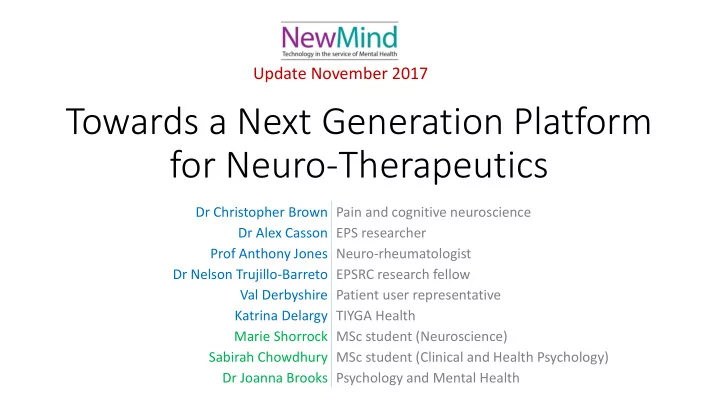

Update November 2017 Towards a Next Generation Platform for Neuro-Therapeutics Dr Christopher Brown Pain and cognitive neuroscience Dr Alex Casson EPS researcher Prof Anthony Jones Neuro-rheumatologist Dr Nelson Trujillo-Barreto EPSRC research fellow Val Derbyshire Patient user representative Katrina Delargy TIYGA Health Marie Shorrock MSc student (Neuroscience) Sabirah Chowdhury MSc student (Clinical and Health Psychology) Dr Joanna Brooks Psychology and Mental Health
Vision: A Neuro-therapeutics Platform Chronic pain Detection of Real-time monitoring of brain states pathophysiology and treatment efficacy Mental health Delivery of targeted neuro-therapies Detecting and treating brain mechanisms of chronic pain and mental ill-health
Example neuro-therapy: Alpha entrainment Ecsy, Jones and Brown, European Journal of Pain, 2016, 2017 Increase in alpha power Decrease in pain processing Reduces pain perception and pain processing in insular cortex
NewMind Plus Stage 1 funding: Aims 1. To gather patient views on new 2. To obtain pilot data for larger technology in healthcare projects / funding opportunities Theme 1: Brain stimulation therapy • Alpha entrainment: Visual • Changes in brain physiology in response to , auditory, tactile, electrical sensory stimulation - to o ptimise stimulation • Patient eligibility, perceptions and preferences protocols Theme 2: Personalised brain monitoring • EEG electrode • Technical development designs t owards quantitative • Patient preferences testing • Identify methods for real - time analysis Theme 3: Smartphone symptom tracking • Patient views on design / capability • Patient - inputted data over 3 months (max)
Work Packages: Overview Work package Description Progress Apps for neural entrainment, tACS Started: July 2017 1. Stimulation technology modifications Completion date: Dec 2017 4 workshops of 4hrs duration Started: Aug 2017 2. Patient workshops involving 24 patients Completion: Dec 2017 (analysis 2018) Longitudinal observation over 3 Started: Aug 2017 3. Smartphone pain diary months in 24 patients Completion date: March 2018 Technical development towards Started: July 2017 4. EEG personalisation adaptability to each patient Completion date: Oct 2017 Literature review and expert Started: Nov 2017 5. Review real-time EEG consultation Completion date: Dec 2018 data modelling Proof-of-concept quantitative EEG Started: Oct 2017 6. Experimental study during sensory stimulation Completion date: April 2018
1. Stimulation technology Visual Stimulation • App displays rapidly flashing light, applied via a VR headset Auditory Stimulation • App plays binaural beats at the same frequency as alpha waves Tactile Stimulation • App produces vibrotactile stimulation at alpha frequency • Electrical stimulation for lab studies Transcranial Alternating Current Stimulation • Alternating current applied at the same frequency as alpha waves
2. Patient workshops: Topics Topics Participants i. Introduction to the project TOTAL: 23 ii. Smartphone pain diary apps Workshop 1: 5 iii. Customising EEG for neuro-therapy Workshop 2: 6 Workshop 3: 9 (2 returning) iv. Visual/auditory/tactile/tACS demonstration and try-out Workshop 4: 11 (6 returning)
2. Patient workshops: Findings Interest in using apps to monitor % Patients passing screening per stimulation Selected patients comments upon chronic pain trying visual stimulation: Not Intere intere “Took away my awareness of a sted sted particularly nasty ache.” “Stimulating and relaxing… helped to take my mind off the pain.” “Wouldn’t choose to use it” Very “I became hyper after a while and intere disorientated” sted Progress/projections • July 2017: Student intern for 10 weeks • Dec 2017: Final patient workshop • Aug 2017: First patient workshop • Jan 2018: Qualitative analysis of audio transcripts • Oct 2017: MSc student in Clinical and Health • Jun 2018: Anticipated completion Psychology recruited
3. Smartphone pain diary Patient use: • 13 patients began using the apps • 9 patients are still using the apps • Tracking e.g. pain, mood, activity, sleep (patient choice) • Max 3 months use per patient Progress/projections: • Aug 2017: First patients started use • March 2018: Last patients will end use
3. Smartphone pain diary
4. EEG personalisation Starting state-of-the-art Now • Ag/AgCl for better sensing • Flexible • Many more shapes • User comfort testing (central leg important) • Controlled test setup 11
• Building on EPSRC fellowship research of Dr Nelson Trujillo- 5. Brain state (EEG) modelling Barreto • Accurate models of brain state changes are required for close- loop interventions. • Brain states are assumed to have characteristics of switching dynamics : 1. Discrete and differentiable 2. Causally-related 3. Dynamical: changing over time Progress/projections: • • Nov 2017: Discussions on real-time implementation Switching dynamics models • May 2018: Toolboxes applied to NewMind project data (widely used in robotics), are now • Dec 2018: Matlab toolboxes publicised; technical papers published; being applied to infer brain companion review article published networks dynamics from EEG
6. Experimental study Visual stimulation Entrainment of alpha oscillations ERP measures of neural plasticity P300 Progress/projections: • Sept 2017: MSc Neuroscience student started on project • Oct 2017: Pilots started in healthy volunteers (N=5, protocol development) • Dec 2017: Patient study to begin (N=24) • April 2018: Anticipated end date
Further funding Current funding (beyond NewMind) Clinical studies: MRC CiC (Jan 2018 – Oct 2018), £68,000 • Funding a post-doctoral researcher • Extension of experimental studies in chronic pain patients to N=50 in total • Pilot trial of neural entrainment and EEG in patients’ homes Near-term funding needs Technology development: NewMind Stage 2 / EPSRC? DSTL? InnovateUK? • Further validation of electrodes – 3D and inkjet printed • Computational acceleration for ‘real - time’ brain modelling • Tactile stimulation: repurposing existing TENS machines • Automated analysis of numerical and text inputs to apps
Recommend
More recommend